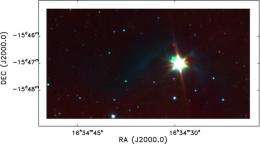Studying a Star Before it is Born

(PhysOrg.com) -- The first phase of a star's formation are thought to begin deep inside a natal cloud of gas and dust. In the earliest stages, material coalesces under the influence of gravity into so-called "dense cores," which, because they absorb optical light, are sometimes seen in the sky as black shapes against a background of stars or nebulosity.
Using modern technologies, however, astronomers today can measure both faint infrared emission from the dust as well as millimeter emission from molecules in the gas. The molecules are especially powerful probes, because their emission is a diagnostic of the chemical history of the cloud, its temperature structure, its evolutionary history, its internal motions, and more.
Astronomers are particularly interested in the earliest stages of these dense cores, even before a star appears. Lynds 43E is one of these dense cores, and is among the most optically opaque clouds known. Its mass, estimated from submillimeter studies, is about 0.8 solar-masses. It is relatively close by, about 420 light-years, in the constellation of Ophiuchus, and is associated with a much larger molecular cloud. There is also a young star very nearby it that conveniently offers a comparison for chemical signature studies.
SAO astronomer Tyler Bourke, together with three of his colleagues, studied the nature of Lynds 43E and its neighbor using millimeter observations of the carbon monoxide molecule and a set of rarer molecules, combined with dust emission as measured by the Spitzer Space Telescope's infrared cameras and other facilities.
They modeled the data to derive the physical conditions in each source, and a picture of how the local chemistry evolved. The scientists present a reasonable picture of where the various molecules are located throughout the core (each one has its own characteristic distribution) and how that distribution likely has evolved in time. In the end, they conclude that this dense core is about 2 million years old. The results are an important step in the meticulous unraveling of the very earliest stages of star formation.
Provided by Harvard-Smithsonian Center for Astrophysics (news : web)



















